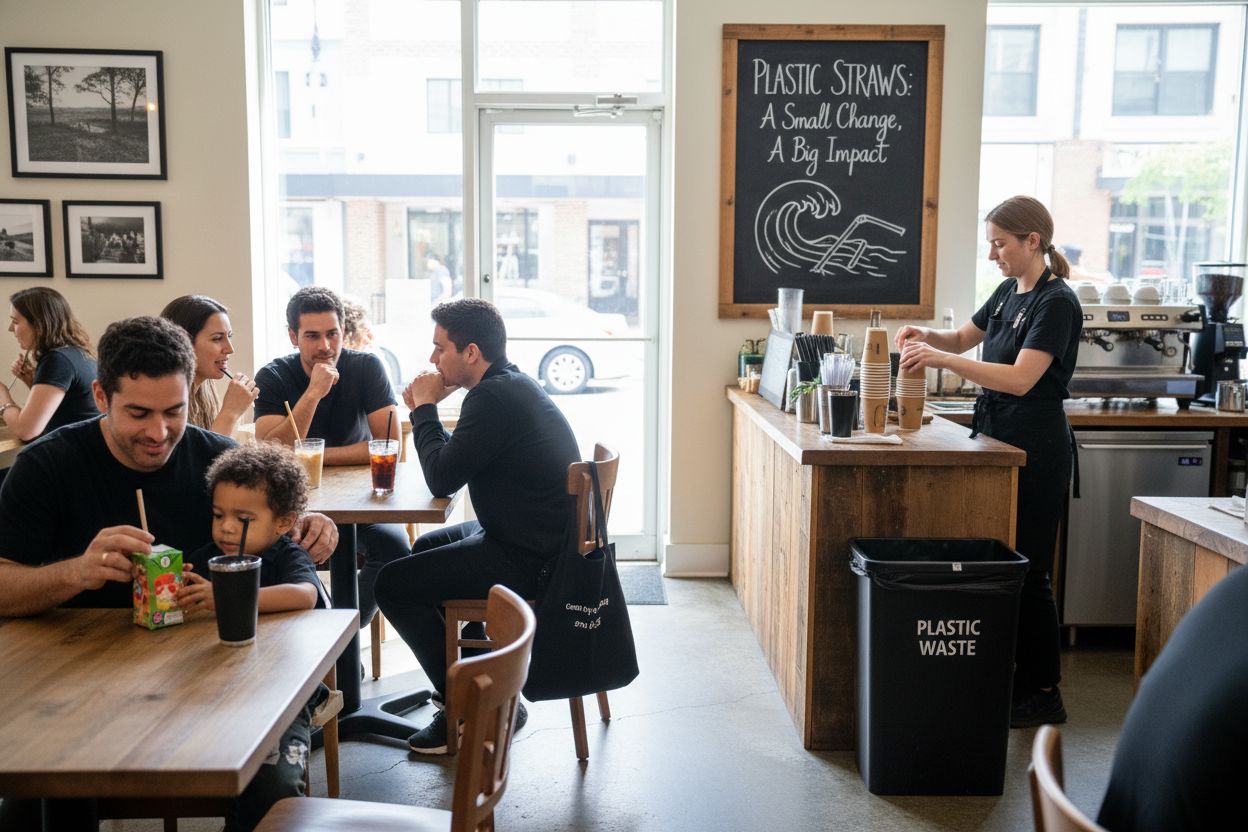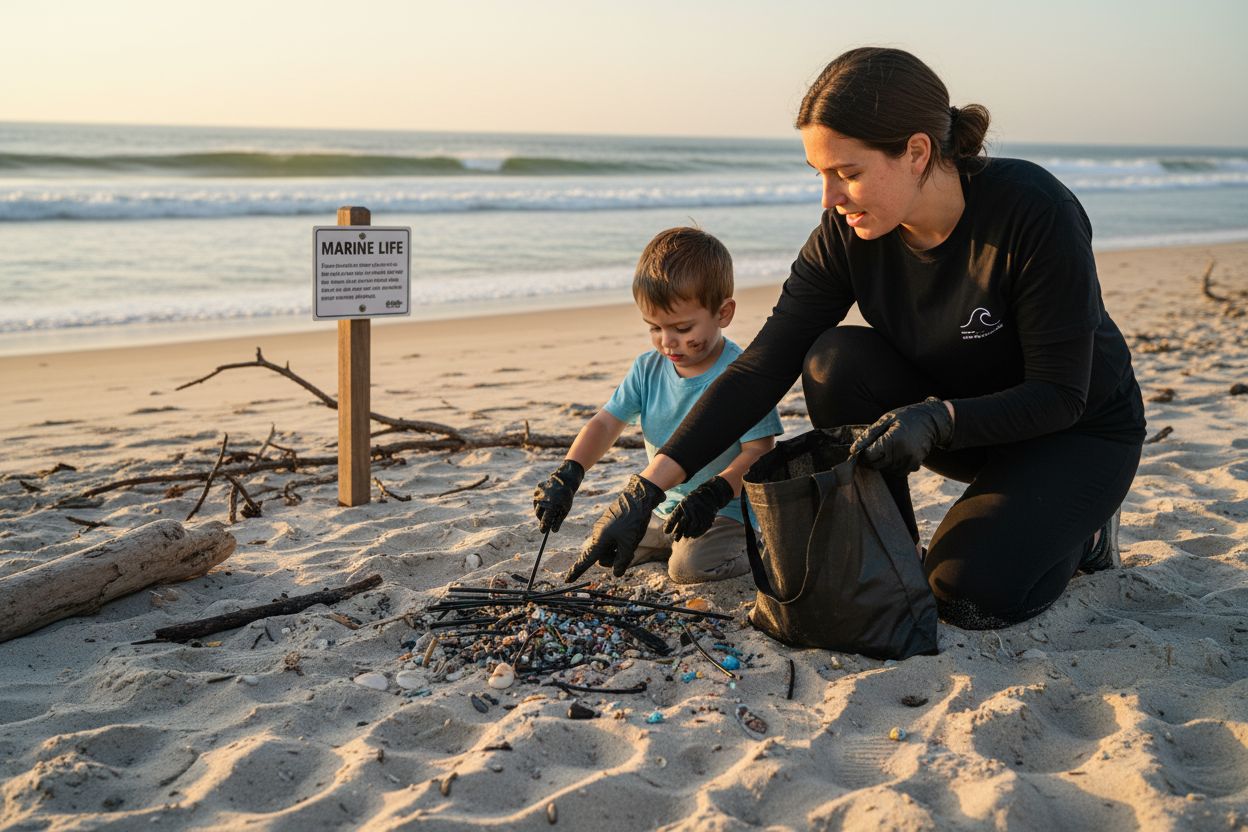Understanding the Impact of Plastic Straws on the Environment

Plastic straws seem harmless and almost invisible in daily life, given how common they are in restaurants and homes. Yet, it might shock you that millions of plastic straws are thrown away around the world every day, ending up in oceans and landfills. The surprising part is that most recycling centers cannot process them, so a simple straw can linger in nature for centuries and quietly damage our planet in ways most people never imagine.
Table of Contents
- What Are Plastic Straws And Their Uses?
- Why Do Plastic Straws Matter To The Environment?
- How Plastics Affect Marine Life And Ecosystems
- The Lifecycle Of A Plastic Straw: From Production To Pollution
- Exploring Sustainable Alternatives To Plastic Straws
Quick Summary
| Takeaway | Explanation |
|---|---|
| Plastic straws are a major pollution source. | Millions of plastic straws are used daily, contributing significantly to global plastic waste. |
| Plastic straws take centuries to decompose. | They photodegrade into microplastics but do not biodegrade, harming ecosystems long-term. |
| Marine life is severely impacted by straws. | Marine animals often ingest plastic straws, leading to fatal consequences and disrupting food chains. |
| Sustainable alternatives exist for plastic straws. | Biodegradable options made from plant-based materials reduce environmental harm effectively. |
| Consumer choices can drive change. | Choosing sustainable straw options influences market trends and encourages eco-friendly production practices. |
What Are Plastic Straws and Their Uses?
Plastic straws represent a ubiquitous single-use product designed for convenient liquid consumption. These thin, hollow tubes made from petroleum-based plastic polymers have been a staple in food service, hospitality, and personal beverage consumption for decades. Their lightweight, disposable nature made them an attractive option for restaurants, cafes, and consumers seeking quick, convenient drinking solutions.
Origins and Manufacturing Process
Manufactured primarily from polypropylene or polyethylene, plastic straws undergo an extensive production process. Raw plastic materials are heated, melted, and extruded through precise molds to create uniform, flexible tubes. Learn more about our sustainable straw alternatives that address the environmental challenges posed by traditional plastic straws.
Key characteristics of plastic straws include:
- Lightweight and inexpensive to produce
- Flexible and easily disposable
- Available in multiple sizes and colors
- Resistant to liquid breakdown
Common Applications and Usage Sectors
Plastic straws have found widespread use across multiple industries. Restaurants, fast food chains, bars, and cafes typically provide these straws with cold and hot beverages. The hospitality sector consistently utilizes them for guest convenience, from hotel room service to poolside drink service. According to Ocean Conservancy, millions of plastic straws are used and discarded globally each day, highlighting their pervasive presence in consumer culture.
Beyond food service, plastic straws serve various purposes in medical, personal care, and recreational settings. Children’s drink packaging, hospital patient care, and outdoor events frequently incorporate these simple yet functional drinking tools. Their low production cost and disposable nature have made them a default choice for quick liquid consumption across multiple contexts.
Why Do Plastic Straws Matter to the Environment?
Plastic straws represent a significant environmental challenge due to their widespread use and problematic disposal characteristics. These seemingly innocuous items contribute substantially to global plastic pollution, creating long-lasting ecological consequences that extend far beyond their brief moment of utility. Explore sustainable alternatives to plastic straws that can help mitigate these environmental impacts.
Lifecycle and Waste Generation
Unlike organic materials, plastic straws do not biodegrade. Instead, they photodegrade, breaking down into smaller microplastic particles that persist in the environment for hundreds of years. According to National Geographic, approximately 8 million metric tons of plastic enter our oceans annually, with single-use items like straws playing a considerable role in this environmental crisis.
Key environmental challenges of plastic straws include:
![]()
- Extremely slow decomposition rate
- High potential for marine and wildlife contamination
- Non-recyclable in most municipal waste systems
- Minimal economic value for recycling infrastructure
Ecological Impact on Marine Ecosystems
Plastic straws pose a severe threat to marine life and ocean ecosystems. Marine animals frequently mistake these plastic items for food, leading to fatal ingestion and entanglement. Sea turtles, birds, and marine mammals suffer devastating consequences from plastic pollution. Microplastics generated from straw degradation enter the food chain, potentially impacting human health through bioaccumulation in seafood and marine organisms.
 The environmental cost of these single-use items far outweighs their momentary convenience, making them a critical concern for global conservation efforts.
The environmental cost of these single-use items far outweighs their momentary convenience, making them a critical concern for global conservation efforts.
How Plastics Affect Marine Life and Ecosystems
Plastic pollution represents a catastrophic environmental threat to marine ecosystems, creating complex and far-reaching consequences for oceanic biodiversity. The intrusion of plastic materials, including straws, disrupts delicate marine food chains and creates systemic challenges for aquatic organisms. Explore strategies for preventing ocean pollution and understand the critical environmental impacts.
Direct Physical Harm to Marine Species
Marine animals frequently suffer direct physical trauma from plastic pollution. According to World Wildlife Fund, numerous species experience fatal interactions with plastic debris through ingestion and entanglement. Sea turtles mistake floating plastic for jellyfish, while seabirds consume small plastic fragments, leading to starvation and internal injuries. Microplastics penetrate marine food webs, causing long-term biological disruptions.
Primary mechanisms of marine ecosystem damage include:
- Physical obstruction of digestive systems
- Nutritional deficiencies from plastic consumption
- Increased vulnerability to diseases
- Reduction of reproductive capabilities
Ecosystem-Wide Environmental Contamination
Plastic pollution extends beyond immediate physical harm, fundamentally altering marine ecosystem dynamics. Microplastics act as carriers for toxic chemicals, introducing pollutants that bioaccumulate through marine food chains. Smaller organisms like plankton absorb these particles, transferring contamination upward through predatory relationships. This contamination impacts not just marine life, but potentially human health through seafood consumption, creating a complex environmental challenge that threatens global ecological balance.
This table summarizes the major ways plastic straws harm marine life and disrupt marine ecosystems, providing a quick reference for understanding their full impact.
| Impact Area | Description |
|---|---|
| Ingestion by Marine Animals | Animals mistake straws for food, leading to internal injuries, starvation, or death. |
| Entanglement | Straws and plastic debris can entangle marine creatures, restricting movement or causing injury. |
| Microplastic Contamination | Photodegradation creates microplastics that enter the food chain. |
| Bioaccumulation of Toxins | Microplastics absorb toxins, which accumulate up the food chain and can affect humans. |
| Ecosystem Disruption | Plastic particles and debris interfere with normal ecosystem dynamics and reproduction. |
The Lifecycle of a Plastic Straw: From Production to Pollution
The journey of a plastic straw represents a microcosm of global plastic consumption and environmental degradation.
From its initial petroleum-based creation to its ultimate disposal, each straw embodies a complex narrative of industrial processes and ecological consequences. Learn more about sustainable recycling alternatives that can help mitigate these environmental challenges.
Manufacturing and Raw Material Extraction
Plastic straws begin their existence in petroleum refineries, where crude oil undergoes extensive processing to extract polymers like polypropylene. These raw materials undergo high-temperature extrusion processes, transforming liquid petrochemicals into solid, flexible tubes. According to National Geographic, the energy-intensive manufacturing process for single-use plastics generates significant carbon emissions and contributes to global environmental stress.
Key stages of plastic straw production include:
- Crude oil extraction from geological deposits
- Refining petrochemicals into plastic polymers
- Melting and molding polymers into straw shapes
- Packaging and distribution to global markets
Disposal and Long-Term Environmental Impact
Once discarded, plastic straws enter a troubling environmental trajectory. Most municipal recycling systems cannot process these small, lightweight items, leading them to accumulate in landfills or escape into natural environments. Microplastics generated from straw degradation persist for hundreds of years, gradually fragmenting into smaller particles that infiltrate soil, waterways, and marine ecosystems. Their minimal economic value and complex chemical composition render traditional recycling methods ineffective, perpetuating a cycle of continuous environmental contamination.
The following table compares traditional plastic straws with sustainable alternatives based on characteristics and environmental impact.
| Type of Straw | Material Source | Decomposition Time | Environmental Impact | Recycling/Composting |
|---|---|---|---|---|
| Plastic Straw | Petroleum-based plastic | Centuries (does not biodegrade) | Significant, leads to microplastics | Not recyclable in most systems |
| Biodegradable Straw | Plant-based materials | Months to a few years | Minimal, decomposes naturally | Compostable |
| Compostable Straw | Wood pulp/agri waste | Months to a few years | Low, breaks down into organic matter | Compostable |
Exploring Sustainable Alternatives to Plastic Straws
The global movement towards sustainable drinking solutions has accelerated the development of environmentally responsible straw alternatives. Innovative materials and design approaches are emerging to address the significant ecological challenges posed by traditional plastic straws. Discover plant-based straw innovations that are transforming the single-use beverage industry.
Biodegradable and Compostable Solutions
Modern sustainable straw alternatives focus on materials that decompose naturally without causing long-term environmental damage. Plant-based materials like wood pulp, agricultural waste, and specialized plant fibers offer promising solutions. According to UN Environment Programme, these innovative materials can significantly reduce plastic waste while maintaining functional drinking experiences.
Key characteristics of sustainable straw alternatives include:
- Rapid natural decomposition
- Minimal environmental footprint
- Comparable drinking performance to plastic
- Sourced from renewable resources
Environmental and Economic Considerations
Sustainable straw alternatives represent more than an ecological choice they signal a broader shift in consumer and industrial practices. While initial production costs may be higher than traditional plastic, the long-term environmental benefits are substantial. These alternatives reduce microplastic pollution, decrease carbon emissions associated with petroleum-based production, and support circular economy principles by utilizing renewable resources and creating biodegradable products.
Make a Real Difference: Switch to Eco-Friendly Straws Today
Are you tired of seeing the harmful impact of plastic straws on our oceans and marine life? The article has shown just how persistent and destructive plastic pollution can be to our environment. It is clear that plastic straws create microplastics that never fully disappear and damage both wildlife and the food chain. For restaurant and hospitality professionals, the pressure is on to find a truly sustainable alternative that does not add to the crisis.

Choose the change by exploring our The Ocean Straw Growth Pack, a complete solution designed for your business. Our wood and plant based straws are compostable and responsibly sourced, so you can serve every drink with confidence and purpose. Do not wait until plastic waste becomes an even bigger challenge. Make your next order at The Ocean Straw and join the movement to protect our planet. The time to act is now.
Frequently Asked Questions
What are the environmental impacts of plastic straws?
Plastic straws contribute significantly to plastic pollution, with a very slow decomposition rate. They can break into microplastics that persist in the environment, harming marine life and potentially affecting human health through the food chain.
How long do plastic straws take to decompose?
Plastic straws do not biodegrade. Instead, they photodegrade and can take hundreds of years to break down into smaller microplastic particles, creating long-lasting environmental issues.
Are there sustainable alternatives to plastic straws?
Yes, there are several sustainable alternatives to plastic straws, including biodegradable and compostable options made from materials like wood pulp and agricultural waste. These alternatives are designed to decompose naturally without long-term environmental harm.
How do plastic straws affect marine life?
Plastic straws pose a severe threat to marine life as animals often mistake them for food, leading to ingestion, entanglement, and death. Microplastics can enter the food chain, causing broader ecological consequences and potential health risks for humans who consume affected seafood.